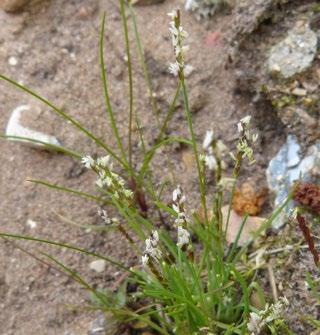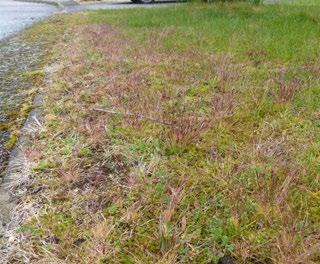
5 minute read
Norfolk Ian Woodward
two alleles. If more plants can be found in other quite disparate colonies, it could feasibly be given a rank at forma (e.g. f. pallida). Thus if encountered, plants could be marked in the comments when recording as ‘pallid form’ or ‘f. pallida name pending’.
Ortiz et al. (1999) did not specifically place the Anglesey plants in subsp. littorea. They stated that most had spikelets ≤2.5 mm, with a few being 3mm, and that such populations needed more study. This places them well within the range of their version of subsp. minima (in which they allow for some overlap between the two subspecies). It seems that it can be concluded, that most if not all populations of Mibora minima here in the UK clearly fall into the range of subsp. minima. Further study at a larger scale may show more overlap with subsp. littorea and it may be of interest that the size of the stomata appeared to be smaller here. However, at present subsp. littorea is rare and only occurs on parts of the NW Iberian Peninsula (Galicia and NW Portugal; Ortiz et al. [1999]; Flora iberica [Castroviejo, 2021]).
Advertisement
Acknowledgements
I would like to thank Nigel Brown, Melinda Lyons, Ian Bonner, Phil Smith, Clive Stace, Robin Walls and Oliver Pescott for their help in preparing this article.
References
Castroviejo, S. (ed) 2021. Flora iberica, Vol. XIX (1):
Gramineae: 52. Mibora minima, pp.591–595. Consejo
Superior de Investigaciones Cientficas (CSIC). Cope, T.A. & Gray, A. (2009). Grasses of the British Isles.
London: Botanical Society of the British Isles. Ortiz, S., Rodrígeuz-oubiña, J. & Guitián, P. 1999. Taxonomic characterization of littoral sabuline populations of Mibora minima (Poaceae) in the northwestern Iberian Peninsula.
Nordic Journal of Botany 19: 581–586. Rich, T.C.G. 1997. Wildlife reports: flowering plants –
England. British Wildlife 8: 328. Smith, P.H, Highfield, C.M. & Lockwood, P.A. 2011.
Changing status of Mibora minima on the Sefton Coast,
Merseyside (v.c.59). BSBI News 118: 28–34. Smith, P., Pescott, O. & Bungard, S.J. 2015. Mibora minima in the north-west of Scotland, on Baleshare Island. BSBI
News 130: 26–27. Smith, P.H. 2005. Mibora minima on the Sefton Coast,
Merseyside. BSBI News 99: 33–34. Smith, P.H. 2007. Recent works at Southport Marine Lake sand-dunes. Report to Sefton Coast Partnership.
Michael Wilcox
43 Roundwood Glen, Greengates, Bradford BD10 0HW
michaelpw22@hotmail.com
A population of Mibora minima (Early Sand-grass) in urban Thetford (v.c. 28) – a first for Norfolk
IAN WOODWARD
After having avoided urban botanising (and people!) during much of 2020, I resolved in 2021 to undertake some ‘square-bashing’, focusing on visiting some of the 1-km squares in Thetford to see how many species I could find over the course of the year. On one such visit, on 24 April, I visited a part of the British Trust for Ornithology’s Nunnery Lakes reserve before using a narrow pathway between two houses leading from the reserve onto a residential cul-de-sac.
At the base of the fence alongside this path I spotted around 5–10 plants of an unfamiliar small grass in flower, with distinctive flowering spikes. It was clearly not an Aira or any of the other Breckland species, so assuming it was of garden origin I took some photos and moved on. When I reviewed the photos it seemed to closely resemble Mibora minima (Early Sand-grass) but I managed to convince myself that it wasn’t this species as the spikelets didn’t seem to be arranged on one side of the pedicel (at least to
Flowering Mibora minima (Early Sand-grass), Thetford, Norfolk (v.c. 28). Ian Woodward
my eyes). It was two weeks later before I tried again to identify the grass by looking on the internet, and then posted the photos on Twitter. Twitter users confirmed quickly that it was Mibora minima.
I met Jo Parmenter and Bob Leaney at the site on 8 May, and found that, in addition to the plants I had previously noticed at the base of the fence, the species was also growing in the gutter and pavement cracks further along the road, and in at least three different garden lawns, each of which were unimproved and typical of Breckland habitat, i.e. characterised by a high abundance of mosses and barer patches. JP estimated that the population consisted of at least 125–150 individual plants in total. The population seems to be well-established and it is likely that it has been here for at least 2–3 years or longer.
The species has previously been recorded in urban areas elsewhere including, in East Anglia, a population which persisted in Woodbridge from 1939 to at least 1986, and a record from Cambridge in 1989.
So where did these plants come from? The romantic option would be that they represent a relict population that has somehow survived in the area within the sandy Brecks habitat that has enabled so many other rare annual species to persist. Whilst this possibility can perhaps not be entirely excluded, it seems fanciful and highly unlikely given the urban location of this population, the fact that Breckland has been well-studied and the lack of any pre-1900 records of the species from East Anglia. A recent, human-assisted arrival seems much more likely, either through the activities and movements of local residents (or botanists?) or brought in along with garden material. There is no obvious reason for botanists to have previously visited this particular cul-de-sac, and movements of local residents or their families/friends seems the most likely explanation. Indeed, JP spoke to a resident whose brother owns a campervan which, when he visits, is parked on the street immediately adjacent to the lawn with the highest density of Mibora minima (50–70 plants). This individual has travelled widely including (pre-Covid) to southern Europe. It seems very plausible that this could have been the vector of arrival.
Acknowledgements
Thanks to Jo Parmenter for her comments on an earlier draft of this article.
Ian Woodward
c/o British Trust for Ornithology, The Nunnery, Thetford IP24 2PU
iwoodward.birder@gmail.com
Mibora minima colony in a garden lawn. Ian Woodward











